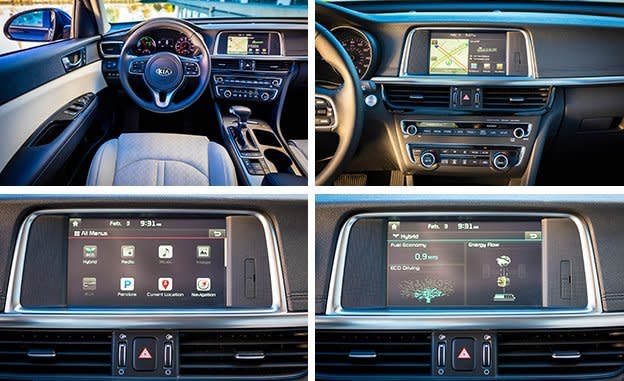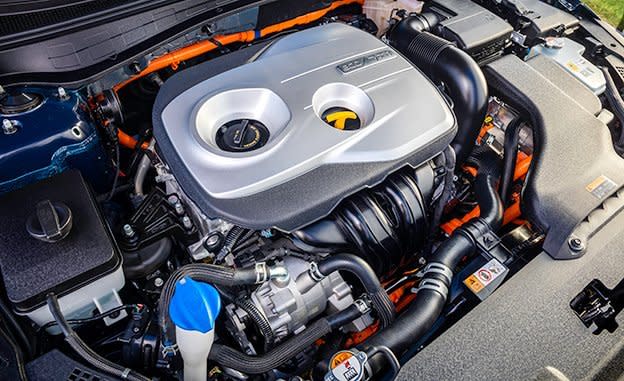2017 Kia Optima Hybrid

Bragging rights among hybrids often come down to a matter of just a few miles per gallon in the EPA ratings. It seems like a somewhat arbitrary metric given the old “your mileage may vary” disclaimer, but fuel economy is nonetheless an important measurement for the engineers, marketers, and consumers of these thrifty machines.
Among hybrid mid-size sedans, the Kia Optima hybrid can’t claim best-in-class mileage—that honor belongs to the Honda Accord hybrid, which achieves 48 mpg combined compared with the Kia’s 42 mpg. The 46-mpg Chevrolet Malibu hybrid also beats the Optima, while others in this class, including the Ford Fusion hybrid and the Hyundai Sonata SE hybrid (the Optima’s corporate cousin), tie the Kia in the government’s testing.

You can’t accuse Kia engineers of not hitting the mark in creating this second-generation Optima hybrid, however. Its thoroughly updated gas-electric powertrain boasts numerous improvements over the previous system, and its fuel economy represents a big jump from the outgoing model’s 37-mpg combined rating. That’s thanks to a more efficient 2.0-liter Atkinson-cycle four-cylinder engine that replaces the previous 2.4-liter unit; a slightly higher-capacity, 1.6-kWh lithium-ion battery pack; and a more powerful, 50-hp electric motor.
Unconventionally Conventional
While most other hybrid systems use continuously variable automatic transmissions (CVTs), the Kia matches its 2.0-liter four-cylinder with a conventional six-speed automatic, with the electric motor and a clutch replacing the torque converter. This slightly unconventional setup pays off in terms of refinement, as it avoids the droning sensation present in many other hybrids when the powertrain is tasked with urgent acceleration.
Another impressive element of Kia’s hybrid system is the way the battery pack fits neatly under the rear seat. With this placement, the Optima’s trunk measures 13 cubic feet, larger than the 12 cubic feet found in the Fusion hybrid or the Malibu hybrid (but 2.5 cubes less than the gasoline-only Optima). The Optima hybrid also maintains the 60/40 split-folding rear seat, which provides a wide pass-through for larger items.

Familiar Optima Goodness
As it is in the standard Optima, the hybrid’s passenger compartment is a satisfying place to spend time. It boasts great fit and finish, an easy-to-use control layout, and comfortable seats front and back. Apple CarPlay and Android Auto connectivity are standard, and options such as a panoramic sunroof, heated leather seats, and a Harman/Kardon audio system create a premium vibe.
With 192 total horsepower lugging a bit more weight than in the standard model, the Optima hybrid doesn’t feel appreciably quicker than the regular four-cylinder, although the instantaneous torque from the electric motor does help make it more responsive when merging or passing. The car’s dynamics are mostly unchanged from the standard Optima, with accurate steering, well-controlled body motions, and a quiet cabin. The only giveaway that you’re piloting a hybrid is the spongy and vague brake-pedal feel, a common sore spot in hybrids because of the difficulty of blending regenerative and friction braking systems. There also are numerous eco-focused menus and displays available in the instrument cluster and dashboard screens for those who are inclined to hypermile their Kias.

Fading Value Equation
Kia’s emphasis on value has softened as of late, as evidenced by this hybrid. While it starts at an attractive $26,845 ($3595 less than the base Accord hybrid), that’s for a relatively sparsely equipped model without items such as power seats or blind-spot warning. A loaded Optima EX hybrid like the one we drove crests $37,000, which is nearly $6000 more than an equivalently equipped Optima EX with a 2.4-liter engine. That’s a tough pill to swallow, especially when gas is cheap—a headwind that all automakers selling electrified vehicles are fighting right now.
Beyond the price premium, however, the Optima hybrid demands few compromises compared with the standard model—so few that it’s easy to forget you’re driving a hybrid. With an impressive blend of practicality, refinement, and style, the Optima is a solid contender among mid-size hybrid sedans, particularly for those who don’t look solely at the EPA numbers.
Specifications >
VEHICLE TYPE: front-engine, front-wheel-drive, 5-passenger, 4-door sedan
ENGINE TYPE: DOHC 16-valve Atkinson-cycle 2.0-liter inline-4, 154 hp, 140 lb-ft; permanent-magnet synchronous AC motor, 50 hp, 151 lb-ft; combined output, 192 hp, 271 lb-ft; 1.6-kWh lithium-ion battery pack
BASE PRICES: Premium, $26,845;
EX, $31,840
TRANSMISSION: 6-speed automatic with manual shifting mode
DIMENSIONS:
Wheelbase: 110.4 in
Length: 191.1 in
Width: 73.2 in Height: 57.5 in
Passenger volume: 105 cu ft
Cargo volume: 13 cu ft
Curb weight (C/D est): 3600 lb
PERFORMANCE (C/D EST):
Zero to 60 mph: 8.1 sec
Zero to 100 mph: 22.1 sec
Standing ¼-mile: 16.2 sec
Top speed: 130 mph
FUEL ECONOMY:
EPA city/highway driving: 39/46 mpg

 Yahoo Autos
Yahoo Autos 